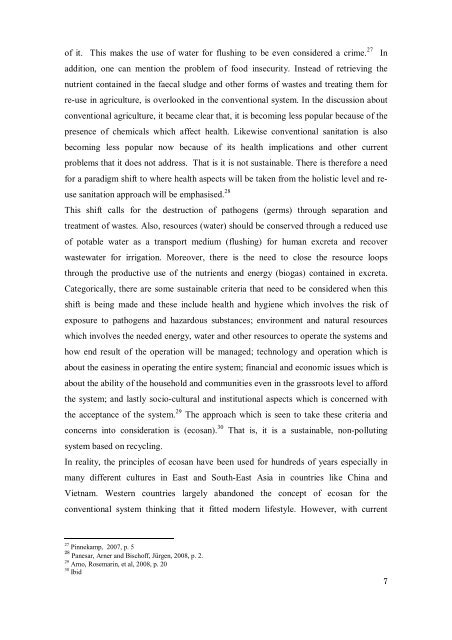A QUANTITATIVE APPROACH TO PREDICT ... - SuSanA
A QUANTITATIVE APPROACH TO PREDICT ... - SuSanA
A QUANTITATIVE APPROACH TO PREDICT ... - SuSanA
You also want an ePaper? Increase the reach of your titles
YUMPU automatically turns print PDFs into web optimized ePapers that Google loves.
of it. This makes the use of water for flushing to be even considered a crime. 27 In<br />
addition, one can mention the problem of food insecurity. Instead of retrieving the<br />
nutrient contained in the faecal sludge and other forms of wastes and treating them for<br />
re-use in agriculture, is overlooked in the conventional system. In the discussion about<br />
conventional agriculture, it became clear that, it is becoming less popular because of the<br />
presence of chemicals which affect health. Likewise conventional sanitation is also<br />
becoming less popular now because of its health implications and other current<br />
problems that it does not address. That is it is not sustainable. There is therefore a need<br />
for a paradigm shift to where health aspects will be taken from the holistic level and reuse<br />
sanitation approach will be emphasised. 28<br />
This shift calls for the destruction of pathogens (germs) through separation and<br />
treatment of wastes. Also, resources (water) should be conserved through a reduced use<br />
of potable water as a transport medium (flushing) for human excreta and recover<br />
wastewater for irrigation. Moreover, there is the need to close the resource loops<br />
through the productive use of the nutrients and energy (biogas) contained in excreta.<br />
Categorically, there are some sustainable criteria that need to be considered when this<br />
shift is being made and these include health and hygiene which involves the risk of<br />
exposure to pathogens and hazardous substances; environment and natural resources<br />
which involves the needed energy, water and other resources to operate the systems and<br />
how end result of the operation will be managed; technology and operation which is<br />
about the easiness in operating the entire system; financial and economic issues which is<br />
about the ability of the household and communities even in the grassroots level to afford<br />
the system; and lastly socio-cultural and institutional aspects which is concerned with<br />
the acceptance of the system. 29 The approach which is seen to take these criteria and<br />
concerns into consideration is (ecosan). 30 That is, it is a sustainable, non-polluting<br />
system based on recycling.<br />
In reality, the principles of ecosan have been used for hundreds of years especially in<br />
many different cultures in East and South-East Asia in countries like China and<br />
Vietnam. Western countries largely abandoned the concept of ecosan for the<br />
conventional system thinking that it fitted modern lifestyle. However, with current<br />
27 Pinnekamp, 2007, p. 5<br />
28 Panesar, Arner and Bischoff, Jürgen, 2008, p. 2.<br />
29 Arno, Rosemarin, et al, 2008, p. 20<br />
30 Ibid<br />
7
















